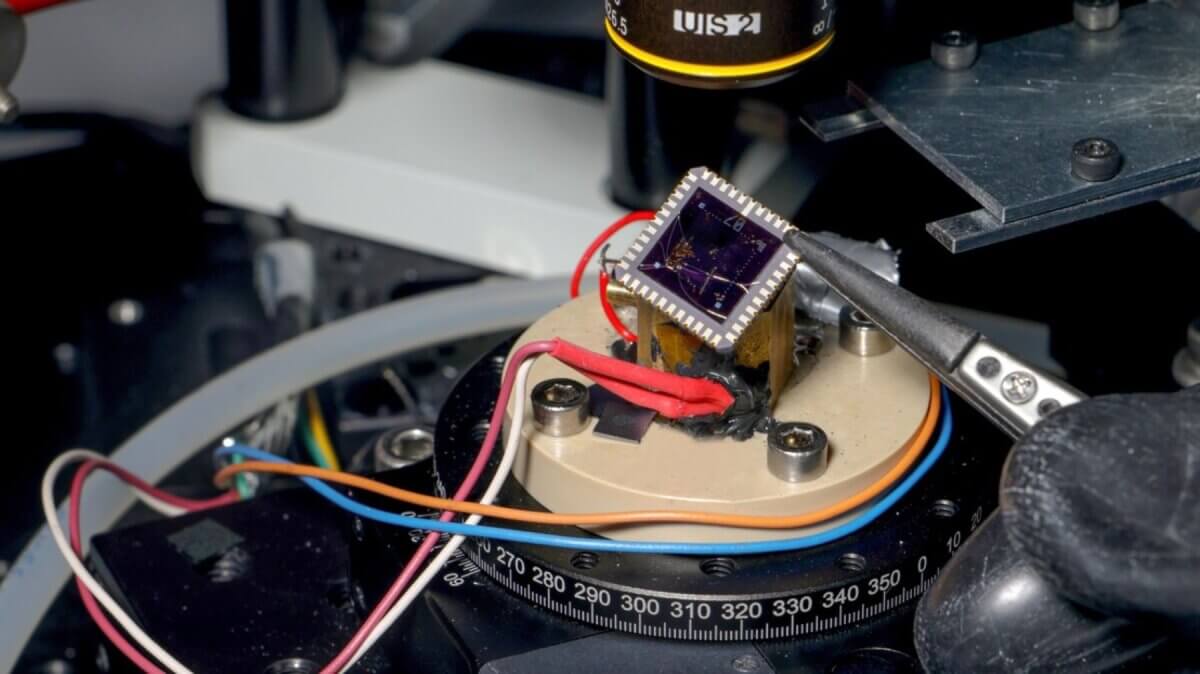
The LANES lab's 2D device made of graphene and indium selenide (© Alain Herzog)
LAUSANNE, Switzerland — Scientists have created a miniature 2D device that can convert heat into electricity with record-breaking efficiency at temperatures lower than in outer space! This breakthrough could revolutionize how we power sensitive quantum computers and explore exotic physics in extremely cold environments.
In the journal Nature Nanotechnology, a team of researchers from Switzerland and Japan revealed their electrically-tunable “Nernst effect” device made from atomically-thin layers of different materials stacked together. Their tiny chip, measuring just micrometers across, can generate useful electrical signals from small temperature differences even at a frigid 100 millikelvin - just a fraction of a degree above absolute zero.
The device takes advantage of the “Nernst effect,” where a voltage is generated perpendicular to both a temperature gradient and magnetic field in certain materials. While this effect has been known for over a century, making it work well in extreme cold has been an ongoing challenge — until now.
“We are the first to create a device that matches the conversion efficiency of current technologies, but that operates at the low magnetic fields and ultra-low temperatures required for quantum systems. This work is truly a step ahead,” says Gabriele Pasquale, a PhD student at EPFL’s Laboratory of Nanoscale Electronics and Structures (LANES), in a media release.

The key to the team's success was carefully combining different two-dimensional materials into a “van der Waals heterostructure” - essentially a stack of ultra-thin layers held together by weak atomic forces.
They started with a base layer of graphene - a single-atom-thick sheet of carbon with excellent electrical properties. On top of this, they placed a few layers of indium selenide (InSe), a semiconductor with intriguing thermoelectric characteristics. The whole stack was then encapsulated in insulating layers of hexagonal boron nitride for protection.
The researchers fabricated their devices using advanced clean-room techniques to ensure the highest quality and purity of materials. They then cooled the chips down to just above absolute zero in a special refrigerator called a dilution fridge.
To test the devices, the team used a focused laser to create localized heating and sophisticated electronic measurements to detect the resulting signals. They also applied magnetic fields and varied the electrical charge in the device using additional electrodes.
Key Results
The team observed a Nernst effect signal that could be switched on and off electrically with an unprecedented ratio of 1,000 to 1. This means the device can be precisely controlled using standard electronic components.
Even more impressively, they measured a Nernst coefficient - a measure of the strength of the effect - of 66.4 microvolts per kelvin per tesla. This is the highest value ever reported at such low temperatures and modest magnetic fields.
The researchers also found that their heterostructure design amplified the Nernst effect compared to using graphene or indium selenide alone. This synergistic enhancement points to new ways of engineering improved thermoelectric materials.
“If you think of a laptop in a cold office, the laptop will still heat up as it operates, causing the temperature of the room to increase as well. In quantum computing systems, there is currently no mechanism to prevent this heat from disturbing the qubits. Our device could provide this necessary cooling,” Pasquale explains.

Takeaways: Exploring the Implications For Future Technology
This breakthrough has significant implications for both fundamental physics and practical applications. On the basic science side, it provides a new tool for probing exotic quantum states of matter that only emerge at ultra-low temperatures.
On the applied side, the technology could find use in quantum computing, where precise control of heat flow is critical. It might enable new types of quantum sensors or help manage waste heat in superconducting circuits.
The team is now working to further optimize their devices and explore different material combinations. They're also investigating how to scale up production for practical applications.
“These findings represent a major advancement in nanotechnology and hold promise for developing advanced cooling technologies essential for quantum computing at millikelvin temperatures,” Pasquale concludes. “We believe this achievement could revolutionize cooling systems for future technologies.”










